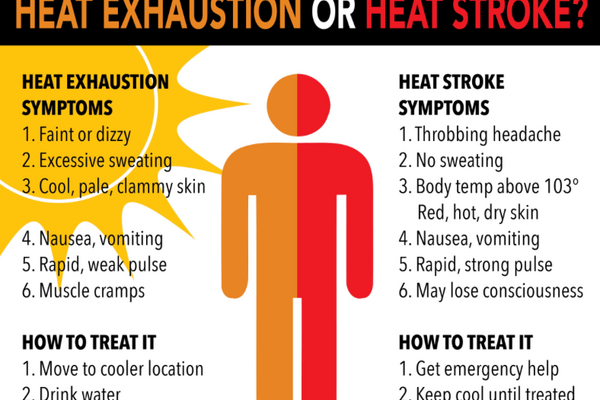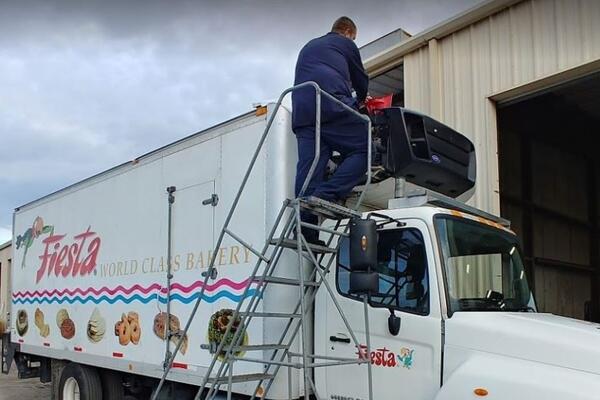For Many, the Heat has Been Here For Quite Some Time
With much of the U.S. experiencing unprecedented heat and drought, you’ll want to consider the following precautions to beat the heat while on the road during these hot summer months.
Stay Hydrated: It’s easy to forget to drink water while on the road, but it’s extremely important to stay properly hydrated - particularly during the hottest months of the year. Keeping a couple of bottles of water next to you while you’re driving will serve as a constant reminder and make it practical for you to drink water throughout the day.
Keep Tires Inflated: In the higher temperatures of the summer, the chance of tire blowouts increases. Under-inflated tires can further increase the risk for blowouts, so you’ll want to be sure you check that your tires are properly inflated before you drive.
Check Your Brakes Regularly: Check your brakes before you start your drive because higher temperatures can result in a loss of friction when the brake parts can’t absorb any more heat.
Protect Yourself from the Sun: Spending several hours, a day driving means you will have a lot of sun exposure. Don’t forget to follow sun safety tips like wearing sunscreen and wearing long sleeves.
Be Aware of Crowded Roads: Roads tend to be a lot more crowded during the summer months with families taking vacations and a lot more people having time off work. Heavy traffic volume presents more dangers for truck drivers, so you’ll want to be extra alert and aware of other vehicles on the road.
Know the Signs of Serious Heat-Related Illness: If you must load and unload freight or do other heavy work in hot conditions, you could succumb to a heat-related illness before you realize how sick you are. Two risky heat-related conditions are heat exhaustion and heatstroke.
Heat exhaustion is a serious medical problem that may or may not require medical attention. Signs of heat exhaustion include the following symptoms:
- Sweating profusely
- Skin that’s cold and clammy
- Pulse that’s faint and rapid
- Cramps in stomach and/or muscles
- Exhaustion
- Dizziness and headache
- Fainting
- Sick to the stomach
If you or another worker is showing the above signs of heat exhaustion, move the affected person to a cool spot, loosen their garments, and apply cold compresses. The person should take small sips of water and seek professional medical care if they’re vomiting or if symptoms continue past an hour.
Heatstroke is another medical emergency and always requires immediate medical care. Signs of heatstroke include the following:
- Body temperature above 103 degrees Fahrenheit
- Skin that’s hot to the touch
- Skin that’s red; skin that’s dry or damp
- Dizziness and nausea
- Disorientation
- Loss of consciousness
According to the U.S. Centers for Disease Control, you should move a person suffering from heatstroke to a cool location while another person (or you if you’re alone) contacts 911. Use cold, wet cloths to help lower the heat-affected person’s body temperature or assist the heat-affected person with a cool bath until first responders are on the scene. Never give a person with heatstroke a sip of water.
Pay Attention to these A/C System Failure Warning Signs
When issues with your A/C system begin to occur internally, your truck will give you some warning signs. Listen to your truck and invest the time now to avoid spending more time in the shop later on.
If you experience one or more of the following, you should have your A/C system inspected by a professional technician:
- Lack of air flow coming from the vents
- Warm air instead of cool
- A noisy compressor
- A lack of water dripping from the cab drain tube when A/C is running (when the humidity increase, so should the amount of moisture dripping)
Follow these best practices when it comes to year-round maintenance to increase the reliability of your truck's A/C system:
- Have your cabin filters replaced as needed or according to the manufacturer's recommendations.
- Keep the condenser on the front of the cab clean.
- Keep the compressor belt tight and in good condition.
- Don’t wait until the hottest day of summer to service your truck’s A/C system needs to be serviced.
Tips For Getting the Most Out of Your Reefer Unit In Hot Climates
A proper pre-trip on ThermoKing and Carrier units is the start to Loading Best Practices:
- Initiate an automatic pretrip to identify any operational concerns while the reefer cycles through all its modes. Do not load truck/trailer if alarm codes indicate service is needed.
- Inspect the condition of the truck/trailer, noting any damage to the insulation, door seals, and defrost drains.
- Clean inside of truck/trailer. To prevent contamination hazards and blockage of airflow, the floor channels and refrigeration unit air stream must be free of debris.
- Pre-cool truck/trailer:
- Always pre-cool truck/trailer to the temperature of the product to be loaded. Doing so will remove unwanted heat from the truck/trailer walls, floor, and ceiling. Remember refrigeration units are not designed to lower product temperature.
- Load product with the proper loading pattern:
- Product should be loaded quickly and efficiently using the proper loading patterns that maximize air circulation around and through the product load. Product should never be loaded tightly against the evaporator housing, doors, walls, ceiling, or tightly against other pallets of product. All six sides of all pallets should be exposed to airflow.
Delivery Best Practices:
- Inspect strip curtains (if used), report any damage to your supervisor.
- Be certain reefer unit is off when opening doors, reefers will pull in warm, humid air if the door is left open while the unit is running.
- Minimize door opening duration to further reduce this intake of warm outside air. Remember, the longer the doors are open, the longer it will take to regain the proper temperature.
- Move product quickly when delivering to cross dock locations.









